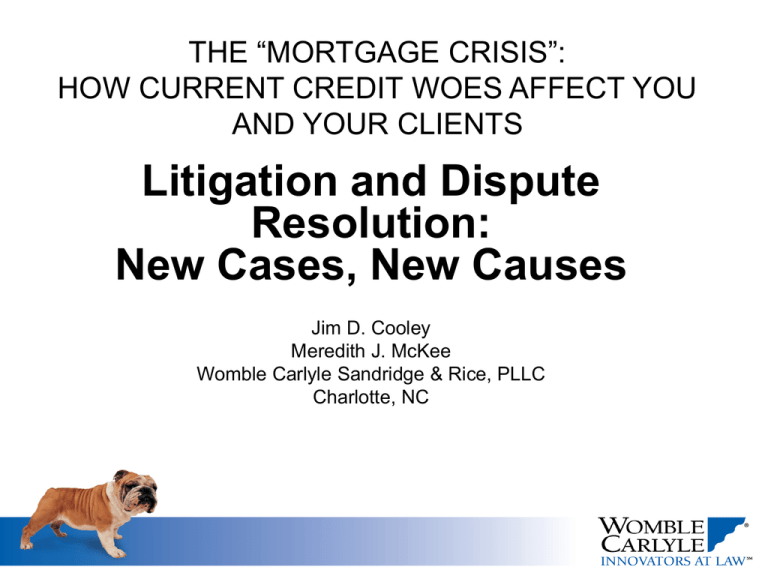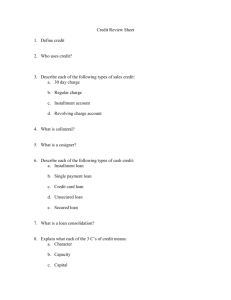mortgage crisis - Womble Carlyle
advertisement

THE “MORTGAGE CRISIS”: HOW CURRENT CREDIT WOES AFFECT YOU AND YOUR CLIENTS Litigation and Dispute Resolution: New Cases, New Causes Jim D. Cooley Meredith J. McKee Womble Carlyle Sandridge & Rice, PLLC Charlotte, NC 1 The Current Litigation Environment New legislation • Federal and state Increased enforcement activity • Federal and state • Civil and criminal penalties Increased litigation • By states’ Attorneys General and regulators • By local governments • By private plaintiffs 2 New Legislation Federal • Housing and Economic Recovery Act of 2008 (signed 7/30/08) Allows FHA to guarantee new loans for subprime borrowers if lenders reduce balance to 90% of home value Increases conforming loan limits in high-cost areas First-time buyer tax credit Provided basis for oversight and now takeover of Government Sponsored Enterprises (Fannie Mae, Freddie Mac) • HOEPA Amendments (generally effective 10/1/09) Prohibits “unfair, abusive or deceptive” lending practices New “higher-priced mortgage loan” regulations, including consideration of “ability to pay” Restrictions on advertising 3 4 5 6 New Legislation (cont.) State • • Mortgage Debt Collection and Servicing Act (eff. 4/1/08) Amendments to N.C. Mortgage Lending Act (H.B. 2463) (eff. 1/1/09) • First time that mortgage servicing subject to NC regulations Unique language requires NC-specific procedures New pitfalls, short fuses and potential for liability Amended again in the short session of 2008 (H.B. 2188) (eff. 10/1/08) to ban yield spread premiums (YSP) on all “rate spread home loan” transactions – N.C. first state to do so. Comprehensive regulation of “mortgage servicers” (defined to include “receiving any scheduled periodic payments from a borrower,” including escrow amounts) Servicers required to: (i) be licensed; (ii) act with “skill, care and diligence”; and (iii) file fee schedules with Commissioner of Banks Expands list of “prohibited activities” Requires 45-day pre-foreclosure notice to borrowers and gives Office of Commissioner of Banks (“OCOB”) additional powers to suspend foreclosure for 60 days Foreclosure moratoria enacted in North Carolina and New York, and being considered in many other states The new North Carolina servicing law imposes delays and additional procedures (e.g., in addition to the 45-day pre-foreclosure notice and OCOB’s authority to suspend foreclosure proceedings at any point in the process by 60 days, (noted above), the Emergency Program to Reduce Home Foreclosures Act (H.B. 2623) (eff. 11/1/08 to 10/31/10) gives OCOB authority to extend the foreclosure filing date up to 30 days beyond the date established in the pre-foreclosure notice). Compare mandatory foreclosure mediation by judicial rule (Philadelphia Court of Common Pleas; effective April 2008) 7 8 9 10 11 Increased Enforcement Activity Federal – civil • • • • SEC – investigations into publicly-traded companies (e.g., 9/3/08 civil complaint against two Credit Suisse brokers – see below) OTS – AIG Bank, F.S.B. FDIC – e.g., investigations of Fremont and Countrywide have been announced FTC – preparing settlements with loan servicers Federal – criminal • Federal-state task forces formed in several cities (New York, Philadelphia, Atlanta, Dallas, Los Angeles) • First indictments (securities fraud, wire fraud, conspiracy) unsealed in E.D.N.Y. on 9/3/08 against two former Credit Suisse brokers for allegedly deceiving customers in the sale of over $1 billion in auctionrate securities by representing that the collateral of the loans was federally guaranteed student loans when they were actually backed, in part, by subprime mortgages and CDOs. 12 Increased Enforcement Activity (cont.) State • Office of Commissioner of Banks Conducts routine examination of mortgage lenders. N.C.G.S. Section 53243.12(i) Brings disciplinary proceedings under the Administrative Procedure Act. N.C.G.S. Section 53-243.12 (with Attorney General’s office) May require restitution to borrowers for violations of Chapter 24. N.C.G.S. Section 53-243.12(j) • Jurisdiction of OCOB limited by Federal preemption to state-chartered institutions See this year’s U.S. Supreme Court decision in Watters v. Wachovia Look for battles over state power to regulate mortgage subsidiaries of national banks 13 Increased Litigation: The “Radiating Ripples of ‘Sub-Prime’ Litigation” Claims against mortgage originators by or on behalf of borrowers [“Bottom Up”] Claims arising from the securitization process by investors, by and against trusts/underwriters and against originators, including insurers, as to which group should bear the ultimate risk of defaults [“Top Down”] Claims involving collateral debt obligations (CDOs) against placement agents, portfolio managers, financial advisors, officers and directors of CDOs, rating agencies, insurers, accountants and perhaps lawyers [“Buyers Burnt”] Shareholder and derivative claims on behalf of classes of shareholders of investment banks, mortgage companies, homebuilders, etc. [More “Buyers Burnt”] See Jayant W. Tambe, “The Radiating Ripples of ‘Sub-Prime’ Litigation” in Those Lowdown Subprime and Credit Crunch Blues and What Every Business Litigator Needs to Know About Them (ABA, Section of Business Law, Aug. 9, 2008). 14 The Variety of “Bottom Up” Claims Actions by states against originators on behalf of borrowers (parens patriae) alleging: • • Deceptive advertising That the fundamental business model of some originators promotes unfair and deceptive practices Actions by local governments against: • • • • A single lender for reverse redlining – City of Baltimore “Wall Street” for creating a public nuisance – City of Cleveland Lenders which have already foreclosed, seeking demolition costs for abandoned homes – City of Buffalo Lenders who are trying to foreclose, seeking injunctions to halt the process – City of San Diego Actions by private plaintiffs: • • • • To halt foreclosure process For breach of “fiduciary” duty For discriminatory practices To enforce “suitability” standards contained in new HOEPA rule and North Carolina law 15 Bottom-Up Claims by States Actions by State Attorneys General against the largest (formerly) independent mortgage originator, Countrywide Home Loans and subsidiaries • California, Illinois, Florida, Connecticut, West Virginia, Indiana • National Association of Attorneys General and its Standing Committee on Consumer Protection provide forum for discussion and coordination • Look for greater coordination among state bank/mortgage company regulators, especially as part of parallel proceedings involving the Attorneys General Claims by State Attorneys General framed primarily around “Little FTC”/unfair and deceptive trade practice statutes 16 The California Approach: Attacking the Business Model Claims focus on the fundamental structure of the subprime, securitization business model as promoting unfair and deceptive trade practices (UDTP). Use of conspiracy claims joined with UDTP claims. Key Allegations: • Easing of underwriting standards and increasing use of “exceptions” to underwriting. • Use of low- or no-documentation loans. • Encouraging “risk-layering” by financing up to 100% of home value through use of “piggybacks.” • Using piggybacks without attention to the total monthly payment and underwriting on basis of “interest-only” payments. • Other allegations relate to deceptive advertising and the creation of a “high pressure” sales environment. 17 18 19 20 Relief Requested Civil Penalties ($2,500 - $10,000 per violation) Preliminary and permanent injunctions against continuation of the practices (but cf. more specific foreclosure injunctions under the Massachusetts approach) Restitution to borrowers • “any money or property, real or personal, which may have been acquired by means of unfair competition” -- California Amended Complaint • “. . . whose homes were lost due to foreclosure. . . .” -- Illinois Complaint • “notify every consumer . . . of the availability of restitution -- Connecticut Complaint Reformation or recession • “. . . rescinding, reforming or modifying all mortgage loans . . . affected by the use of the . . . unlawful acts and practices” -- Illinois Complaint -- Connecticut Complaint 21 The Massachusetts Approach: Halting (or Slowing Down) Foreclosures On May 2, 2008, the Massachusetts Court of Appeals upheld a preliminary injunction against California-based Fremont Investment & Loan and its parent which: • Restricts foreclosure against owner-occupied properties where the mortgage loan is “presumptively unfair” under the state’s Predatory Home Loan Practices Act. • Provides advance notice to the Attorney General before it forecloses on any Massachusetts loan originated and serviced by Fremont. • Extends to any subsequent assignee of any Fremont residential mortgage loan. • On appeal to MA Supreme Court. On June 3, 2008, the Massachusetts Attorney General obtained similar injunction against H&R Block, Option One Mortgage and American Home Mortgage. The complaint adds claims of race discrimination under the Fair Housing Act. 22 23 Massachusetts v. Fremont Investment & Loan Injunction Decision Matrix for Foreclosure (Courtesy of Greenberg Traurig, “Subprime & Mortgage Markets Alert,” May, 2008) Is the mortgage loan owner occupied? Yes No Is the mortgage loan “presumptively unfair”? Is the mortgage loan “presumptively unfair”? Fremont provides AG 30 days written notice (1) ARM teaser period of 3 years or less; (1) ARM teaser period of 3 years or less; (2) “Teaser” rate 3% or more below fully No indexed rate; (2) “Teaser” rate 3% or more below fully indexed rate; (4) LTV is 100%, or prepayment penalty is (3) Borrower DTI ratio exceeds 50% if measured at fully indexed rate; and substantial or extends beyond teaser period. (3) Borrower DTI ratio exceeds 50% if Yes measured at fully indexed rate; and AG does not object within 30 days AG objects within 30 days Fremont provides AG with 45 days written notice before foreclosure, identifying why foreclosure is reasonable (4) LTV is 100%, or prepayment penalty is substantial or extends beyond teaser period AG does not object within 45 AG objects within 45 days Fremont and AG have 15 days to resolve differences Not resolved Resolved Fremont must obtain court order Court considers whether (i) loan is actually “unfair” (i) reasonable steps have been taken to “work out” and avoid foreclosure and (iii) any fair or reasonable alternative to foreclosure exists Not Granted Granted 24 Fremont prohibited from pursuing loan foreclosure Fremont may proceed with loan foreclosure The Massachusetts Approach (cont.) The City Attorney of San Diego has recently taken the Massachusetts approach, seeking to enjoin foreclosure actions (presumably limited to San Diego County) in People of the State of California v. Countrywide Financial Corporation; Bank of America, et al. (July 23, 2008). Cf. Massachusetts v. Doherty: State sued would-be “flipper” who defaulted on multiple loans allegedly obtained by submitting false information, thereby damaging nearby property owners. 25 Actions by State Attorneys General and/or Regulators: What’s Next? Similar actions against other lenders and by other Attorneys General using California or Massachusetts model, or both Emergence of aiding and abetting theories in order to try to draw in affiliated parties up the chain Stepped-up enforcement against originators and servicers by state regulators Perhaps a coordinated effort at a global settlement between Attorneys General and what is left of subprime industry (shades of settlement with tobacco industry) 26 Bottom-Up Claims: Actions by Local Governments Subprime mortgages as a public nuisance: City of Cleveland v. Deutsche Bank Trust Company, et al. City claims that Wall Street securitizers are primarily responsible for a cycle of loans to unqualified buyers, which led to defaults, which led to foreclosures, which led to abandoned homes, depletion of tax base, and increased fire and police protection, thereby creating a public nuisance. Failure to upkeep: City of Buffalo v. ABN AMRO Mortgage Group, Inc. City claims that mortgage holders who foreclosed and then walked away from 57 foreclosed properties should be required to reimburse it for demolition costs ranging from $16,000 to $40,000 each. 27 Bottom-Up Claims: Actions by Local Governments (cont.) Reverse redlining: Baltimore v. Wells Fargo Bank City claims that Wells Fargo, the largest mortgage lender in the City, violated Fair Housing Act by targeting African-American communities for sub-prime and other predatory lending products. The “disparate impact” of these practices are allegedly manifested by much higher foreclosure rates in the African-American neighborhoods than in white neighborhoods. See Gotlieb and McGuinness, “When Bad Things Happen to Good Cities Are Lenders to Blame?” Business Law Today (July/August 2008) 13-17. 28 Bottom-Up Claims: Private Plaintiffs Traditional disclosure-type claims (individual and class actions), which attack the originator’s documentation of the loan, abound. • TILA, HOEPA, RESPA, FACTA, ECOA • Some accompanied by state-law add-ons, such as: Usury Misrepresentation/fraud Breach of the duty of good faith/fair dealing UDTP New theories (or new variations on old theories) include: • “Who holds the note?” foreclosure defense/offense • “Special relationship” claims • Disparate impact on minority applicants through HMDA data • “Suitability” standard for high-cost loans (new HOEPA regs.) North Carolina law, 29 Bottom-Up Claims: “Who Holds the Note?” In re Foreclosure Cases, Civil Action No. 07-CV-2282 (N.D. Ohio): • Federal judge dismissed foreclosures in scathing opinion after Deutsche Bank was unable to prove it held the notes at the time foreclosures were filed. • Case reveals difficulties of presenting MERS (Mortgage Electronic Registration System) and the technology of the “modern” mortgage market to a court. Whittiker v. Deutsche Bank National Trust Company, (N.D. Ohio, filed February 7, 2008): Follow-on class action against Deutsche Bank for FDCPA violations and RICO violations arising out of In re Foreclosure Cases. Action seeks appointment of a receiver for foreclosed properties. 30 Bottom-Up Claims: Special Relationship Claims Tomlin v. Dylan Mortgage Inc., 2000 NC Business Court 9: Judge Tennille declined to dismiss breach of fiduciary duty claim against broker, where broker had entered into exclusive 3 month brokerage agreements with each borrower. • Rose v. SLM Financial Corp., Civil Action No. 3:05-CV-445 (W.D.N.C.): UDTP, breach of contract and breach of good faith and fair dealing claims against broker • Plaintiff attempts to broaden Tomlin to create a fiduciary duty arising from a non-exclusive broker agreement. Smith v. GMAC Mortgage Corp., Civil Action No. 5:06-CV-125 (W.D.N.C.): UDTP, breach of fiduciary duty, breach of contract and negligence claims. • Cf. Hinton v. West (N.C. Supreme Court 1935): Mortgagor and mortgagee as a “relation of confidence.” U.S. District Court Judge Vorhees denied defendant’s Rule 12(b)(6) motion, finding that plaintiff had sufficiently pled a claim for breach of a fiduciary duty “surrounding the mortgagor-mortgagee relationship” which may give rise to an extra-contractual duty to make timely payments from escrow to plaintiff’s homeowner’s insurance carrier. Fiduciary duty by conduct? Iannuzzi v. Washington Mutual (E.D.N.Y. August 21, 2008), as reported on Law.com • Despite NY authority that the mortgage broker generally does not owe a fiduciary duty to a customer, the U.S. District Court denied defendant’s motion to dismiss, finding that “a broker may take on a fiduciary duty by performing tasks and obligations beyond that of an independent broker or traditional middleman,” and that plaintiff had alleged sufficient facts based on a “close relationship” between defendant broker and the plaintiff’s financial advisor. 31 32 33 Bottom-Up Claims: Disparate Impact on Minority Borrowers Miller v. Countrywide Bank, et al. (D.Mass.): Putative class action alleging: Pricing policy contains discretionary component to credit-based pricing policy which allows increase in financing charges and interest mark-ups. While race-neutral on its face, pricing policy resulted in discriminatory impact on African-American applicants, based on data compiled pursuant to the Home Mortgage Disclosure Act (“HMDA”). (Motion to Dismiss denied 7/30/08) Lewis v. Alpha Mortgage and American Home Mortgage Servicing, Inc. (Baytown, Texas): • Reverse redlining claims by African-American homeowner brought under HOEPA and the Texas Constitution, as reported at Law.com on 9/5/08. 34 Bottom-Up Claims: The Emerging “Suitability” Standard Articulated in recent state and federal laws as “ability to repay” North Carolina usury law, Chapter 24, now regulates higher cost home loans, defined as “rate spread home loans,” at N.C.G.S. § 24-1.1F (eff. 1/1/08) • Lender may not make a “rate spread home loan” unless it “reasonably and in good faith believes . . . [borrower] . . . has the ability to repay the loan . . . . N.C.G.S. § 24-1.1F(c) • • Detailed analysis of ability to repay required Limited right by lender to “cure” and to assert bona fide error defense Remedies: Forfeiture of interest in connection with the loan An affirmative recovery of twice the amount of interest already paid Similar laws are in effect in New York, Maine and Maryland The new Home Ownership and Equity Protection Act (“HOEPA”) Rules at 12 C.F.R. § 226.135 (eff. 10/1/09) contains a suitability standard similar to North Carolina. 35 Some (Obvious) Defensive Strategies Which forum? • • • Other parties and claims: • • Cross-claims – assignee liability Counterclaims – borrower misrepresentations and false financial statements Borrower misconduct defenses • • • Removal under CAFA Preemption Compelling Arbitration Unclean hands Fraud Illegality Class action defenses • Subprime loan transactions are complex with many players – unfocused, “shot-gun” attacks by plaintiff destroy predominance or create such a morass of subclasses that the action becomes unmanageable • Borrower misconduct may result in predominance of questions affecting individual class members over questions of law or fact common to the class 36



